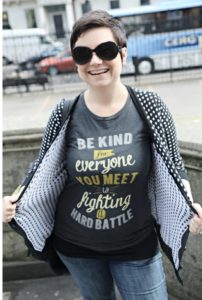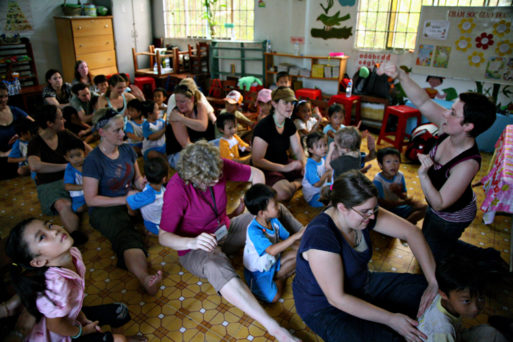Today SevenPonds shares part two of our interview with Tina Allen, the founder and director of Liddle Kidz™ Foundation, an organization that provides education and outreach in the areas of children’s health and nurturing touch. (Read Part One here). A recognized leader in the field of pediatric massage therapy, Ms. Allen brings a wealth of knowledge and experience to her work with children and families all over the world. She has worked to create pediatric massage programs in several major medical centers throughout the United States, including Mayo Clinic and Children’s Hospital Los Angeles, and is the author of the award-winning book, “A Modern Day Guide to Massage for Children.” She also leads a pioneering effort to bring nurturing touch to children in orphanages across the globe.

Tina Allen travels all over the world to spread the word about nurturing touch.
Kathleen: It seems that pediatric massage therapy is extremely beneficial to children with serious and even life threatening illnesses. Can it also be helpful for babies or even premature infants in the neonatal ICU?
Tina Allen: Research demonstrates that nurturing touch is critical to the development of psychological well-being. It becomes even more important when a baby is born prematurely.
Preterm infants and their parents and caregivers face some serious challenges. One of the most significant is bonding. Normally, an infant bonds with its mother or primary caretaker through close physical contact and nurturing touch. But in the NICU, there is limited physical contact between caregivers and the baby due to the child’s medical needs, doctor’s rounds, equipment and the like.
When a baby is very immature, it’s not appropriate to begin providing pediatric massage immediately. Rather, we recommend that parents and staff employ nurturing techniques such as holding, cuddling and comforting. Once the infant is stable enough, limited skin-to-skin contact provides appropriate stimulation and encourages bonding between parent and child.
This skin-to-skin contact may be in the form of placing the baby securely on the parent’s chest, a technique known as Kangaroo Care. A very simple but powerful intervention, it has been shown to stabilize preterm infants and improve outcomes overall.
When we do begin to introduce massage therapy for premature infants, we follow very specific guidelines and protocols. The baby must meet minimal weight and neurological requirements before we can begin. With that said, recent research suggests that the benefits of pediatric massage for preterm infants outweigh the potential negative effects of overstimulation. So, someday those protocols may change.
Infant massage provides many benefits. For example, it can:
- Facilitate weight gain in preterm infants
- Lower levels of the stress hormone, cortisol
- Increase muscle tone
- Improve sleep/wake patterns
- Shorten hospital stays
- Enhance cognitive and motor development at 8 months of age
- Improve developmental scores over time

Giving a presentation in Japan
Kathleen: That’s incredible. It seems that massage and touch can benefit anyone at any age. Is it also beneficial for children on the autism spectrum or those with a sensory processing disorder?
Tina: Many people believe that children with autism do not like being touched. Although this is a common misconception, it is not always the case. Each child is unique. As pediatric massage therapists, we adapt our techniques and approaches to each child’s needs.
Therapeutic massage can be extremely beneficial for children with autism spectrum disorder or sensory processing disorders. However, these children perceive sensations differently, and may have anxiety about touch. Many of them are also very susceptible to sensory overload. This may stem from tactile hypersensitivities or because they previously experienced touch as painful or frightening.
When I advise healthcare providers about working with children with these kinds of disorders, I urge them to move cautiously and respect the child’s cues. It takes time to learn how the child responds to different sensory stimuli, such as types of touch, textures and lubricants.
Kathleen: Do you (or your volunteers) also provide massage for family members to help them cope with the stress of having a child who is seriously ill or dying?
Tina: Providing support to the entire family is at the heart of working in pediatrics. With pediatric massage therapy, we practice a family-centered approach. My philosophy is that if I can decrease the anxiety of everyone around the child, it also directly benefits the child.
So, yes, we encourage not only parents to receive massage therapy, but the medical and nursing staff as well.
Kathleen: I know that Liddle Kidz Foundation offers a number of certification programs for healthcare professionals. Do you also offer training for laypersons who may wish to volunteer or who simply want to learn how to use pediatric massage to help their own children when they’re in distress?
Tina: Family members are always welcome to take our courses. Massage therapy is an intervention that anyone who has the appropriate education can use at home. One of the goals of my work is to empower families to share nurturing touch with their children. Especially when someone is unwell, touch can be very comforting. And parents who know how to use massage to help their child feel more involved and more confident in providing care.
Kathleen: I’d like to switch gears now, and ask you about Liddle Kidz Foundation Global Outreach. I understand you have programs all over the globe. What, specifically, do you do?
Tina: As part of our mission, Liddle Kidz Foundation organizes groups of volunteers to provide hands-on care and education in many countries around the world. We focus on working with organizations and facilities that serve infants and children who have been orphaned or have special healthcare needs. Many of these settings have children ranging in age from babies born prematurely to adolescents.
The number of orphans around the world is astounding. [According to U.S. government estimates, 17.8 million children worldwide have no surviving parent]. There are so many children and so few caregivers. These children don’t have someone to run to their aid when they’re in need. They don’t have someone to hug them and hold them when they’re under stress. Children need to know someone out there cares about them. When this fundamental need goes unmet, all else is lost, and there is no hope of a viable future. It is our moral duty to help these children and let them know they matter.

Tina teaches pediatric massage to the staff at a Vietnam orphanage.
Liddle Kidz Foundation Global Outreach doesn’t just provide hugs and cuddles, we create programs that are sustainable and replicable. Our experience has shown us that orphanages find it challenging to meet the emotional and developmental needs of children. And we know that the best way to support children’s healing is by supporting their caregivers as well.
Our goal, therefore, is to provide the children with nurturing touch while working directly with their caregivers to provide education and support. Thus, we provide healing tools to the caregivers who will stay and work with the children after we are gone.
Kathleen: How do massage and nurturing touch help parentless children?
Tina: Massage is beneficial to almost anyone, but children, in particular, have an essential need for touch. Touch stimulates our brains in many ways, most noticeably in the limbic cortex. That’s the area of the brain that generates emotions and allows us to make connections with others.
The benefits of massage therapy can be achieved during a relaxing 30-minute full body session, or simply by massaging the hands or feet for a few moments. When the staff in orphanages are educated on how best to provide touch therapy, they are more likely to use it as an intervention to improve the children’s health.
The health benefits of massage for children living in orphanages are truly enormous. For example, we trained the staff at one orphanage to use massage therapy with the children in their care. According to the orphanage director, prior to our first visit the staff took the children to the hospital at a rate of approximately 40 times per year. Now, two years later, after using the massage techniques consistently, they only take the children to the hospital around two to three times per year. The orphanage director credits the improvement in the children’s health to the use of pediatric massage.
Kathleen: What an impressive organization! I admire your work more than I can say. Thank you, Tina, for speaking with me today and for sharing your insights with our readers.

 What Is Pediatric Massage Therapy? An Interview with Tina Allen, Part Two
What Is Pediatric Massage Therapy? An Interview with Tina Allen, Part Two


 Our Monthly Tip: Make an “In Case of Death” File to Ease Loved One’s Grief
Our Monthly Tip: Make an “In Case of Death” File to Ease Loved One’s Grief
 Passing of Beloved Comedian Births a New Comedy Festival
Passing of Beloved Comedian Births a New Comedy Festival















